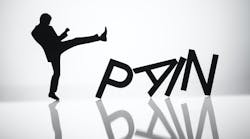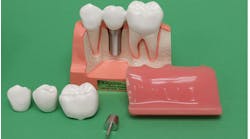The most frequent phone call I receive as a dental ergonomic specialist is from seasoned doctors and hygienists who have increasing pain, asking if I can help them work longer in dentistry. They’ve done the typical temporary treatment (massages, chiropractor, wine and ibuprofen at the end of every workday) and reparative treatment (physical therapy, surgery).
These become null when they return to the same movements that caused their injury. By the time I hear from many dental clinicians, they’re cancelling workdays, calling in sick, and reducing hours and production load to accommodate what they’re able to manage in a day. Many are seriously considering leaving the profession, but they can’t. They need more time to work.
Just the idea of leaving dentistry is often a financial wakeup call. Many clinicians have kids in college, owe practice or student loans, have saved insufficient retirement funds, have staff or family who depend on them, or have recurring medical expenses from years of chairside practice. These clinicians are usually the same ones who have dedicated staff and loyal patients who are begging them not to retire. After all, they’ve spent decades establishing relationships with people. Many love their craft and aren’t ready to hang up their lab coat, even if wearing it hurts.
The income requirements for a lifestyle that’s been established on a dental clinician salary and schedule are hard to find at an entry level position, so leaving dentistry feels like a recipe for financial disaster. These considerations keep many clinicians up at night wondering how they got here in the first place.
If this sounds like you, listen up!
The reality is that as prevention specialists, we should look inward from day one. Instead, we’re taught to focus on developing our billable clinical skills and then on the business of dentistry. Taking care of our most essential instrument (our body) from a prevention perspective goes to the wayside until the pain sets in.
We all know that an ounce of prevention is worth a pound of treatment. To avoid the myriad of expensive physical injuries and mental burnout many of us experience, we have got to take care of ourselves, yet we view ergonomics as an expense instead of a producer on the day sheet. The issue is that there’s no procedure code to pass onto patients for ergonomic training the way there is for other training, so we don’t see the ROI in the same light.
This perspective is the biggest problem. The use and training of ergonomics is the investment equivalent of compound interest. It creates profit and builds upon it. The earlier we employ it, the bigger the dividends become over time. Consider this. What if ergonomic training afforded you the ability to practice with less fatigue, less pain, and less resentment toward the financial chain that keeps you tied to the patient chair when you’re ready to retire?
What if feeling better allowed for more effective patient advocacy and higher case acceptance rates? What if the entire team worked with more energy, more enthusiasm, and more excitement because they felt good? Imagine what a team like that could do! Despite not having a line on the day sheet, the ergonomic ROI could be immeasurably more than any individual billable procedure. You would be more focused on how much treatment you could provide rather than how to take a necessary slow down while not taking a financial hit.
You might also want to read
Dental ergonomics: It's not just posture
Saddle stools: Don’t buy until you try
What is ergonomics in dentistry?
Shifting your mindset starts by understanding what ergonomics is and is not. Ergonomics is not just buying a pair of standard-issue traditional through-the-lens-loupes at school and calling it a day.1 It’s employing sound ergonomic strategies in operator and patient positioning, creating a body-friendly workspace, using equipment that aids in maintaining neutral posture (such as prismatic loupes, a properly fitted and fully adjustable saddle stool, and more), stretching chronically tight muscles throughout the day, developing sufficient posture muscles, and maintaining a schedule that allows for basic human needs such as drinks of water and opportunities to leave the building for mental exhales.
One free and easy ergonomic strategy to incorporate into practice is movement. Humans are not meant to be statuesque all day, especially in a sitting position. A biomechanically destructive snowball begins when sitting or remaining static under load for long periods of time. What starts as an elbow in the air for minutes at a time becomes a trickle of inflammation or tingling in a finger that eventually becomes debilitating pain and a disability claim. To prevent that injury from snowballing, move around and use neutral positioning. Start by standing more. Standing allows for micro-shifting (redistribution of weight) and less overall fatigue.2
Next, practice using ergonomics during treatment. The three-inch hole that we aim to treat with razor sharp instruments requires the use of sight. When we don’t move the patient head, position the patient back far enough, or neglect to use indirect vision, we put our bodies into an awkward position to work. Since awkward positioning is one of the top five risk factors for injury, according to OSHA, we’re literally risking injury with every chicken wing we hold in the air.3
There are ways to get around the rare patient with vertigo or to get to the distal of number two without getting into contortionist positions. Seek help from a certified ergonomic assessment specialist who has dental chairside experience for your individual struggles.
What else can you do ergonomically?
Ergonomic equipment, equipment that aids in keeping you in neutral posture, is essential to working safely. The use of loupes with a light has long been a major contributor to injury prevention and pain relief. Prismatic (ergo) loupes keep the head in complete neutral, eliminating the poor upper body posture that contributes to much of the injury experienced throughout the body, as well as eye strain from 35–45 degrees of declination.4 The use of a fully adjustable saddle stool, cordless equipment, sharp instruments with adequate length, lightweight handpieces, a patient chair with a narrow back so the clinician can move in closer, are all great ways to prevent and reduce pain.
Last, but definitely not least, you have got to learn to take care of yourself before you ever walk in the office. Executing self-care is the eternal struggle. We’ve all heard “drink water,” “sleep eight hours a day,” “exercise three times a week,” “eat nutritious food,” and more. Walking that walk is easier said than done when the world is constantly pulling you in a thousand directions. Self-care often competes for your most valuable asset: time. We can and must make an investment of time now to get that extra 10 years later. Schedule and honor that time the way you expect a patient to schedule and honor their time with you.
Frequent and proper stretching of chronically tight muscles such as the chest, anterior shoulders, and hip flexors throughout the day is a major game-changer for many clinicians. This can be as simple as leaning into a door jam on a forearm with the upper arm parallel to the floor.
The musculoskeletal system maintains integrity when there’s sufficient muscle mass to hold the bones in neutral posture. Without it, you slouch and develop poor neuromuscular patterns. Resistance train three times a week, even if it’s only for 30 minutes. This is an investment that clinicians can’t afford to avoid if they want to experience high productivity, energy, and longevity in their pain-free career.
The payout is that when we work without pain, fatigue, and stress we’re better clinicians, leaders, friends, and spouses. We advocate for our patients better, and without fail, production increases, office culture becomes more positive, and we go home feeling good.
In this case, the ROI of prevention is in giving better care and getting a raise at the same time. It’s time we start building compound interest in our injury prevention so that we aren’t making that phone call to someone like me asking for 10 more years in of working.
Besides, how nice would it be to give your patients, staff, and family a happy, energetic version of yourself?
Katrina Klein, RDH, CEAS, CPT, is a 15-year registered dental hygienist, national speaker, author, competitive bodybuilder, certified personal trainer, certified ergonomic assessment specialist, and biomechanics nerd. She’s the founder of ErgoFitLife, where she teaches that ergonomics and fitness are a lifestyle to prevent, reduce, and even eliminate workplace pain.
Editor's note: This article appeared in the November 2023 print edition of Dental Economics magazine. Dentists in North America are eligible for a complimentary print subscription. Sign up here.
References
- Lietz J, Ulusoy N, Nienhaus A. Prevention of musculoskeletal diseases and pain among dental professionals through ergonomic interventions: a systematic literature review. Int J Environ Res Public Health. 2020;17(10):3482. doi:10.3390/ijerph17103482
- Pejcić N, Jovicić MĐ, Miljković N, Popović DB, Petrović V. Posture in dentists: sitting vs. standing positions during dentistry work–an EMG study. Srp Arh Celok Lek. 2016;144(3-4):181-187.
- Ergonomics overview. OSHA. Accessed August 22, 2023. https://www.osha.gov/ergonomics
- Aldosari MA. Dental magnification loupes: an update of the evidence. J Contemp Dent Pract. 2021;22(3):310-315. PMID: 34210934






